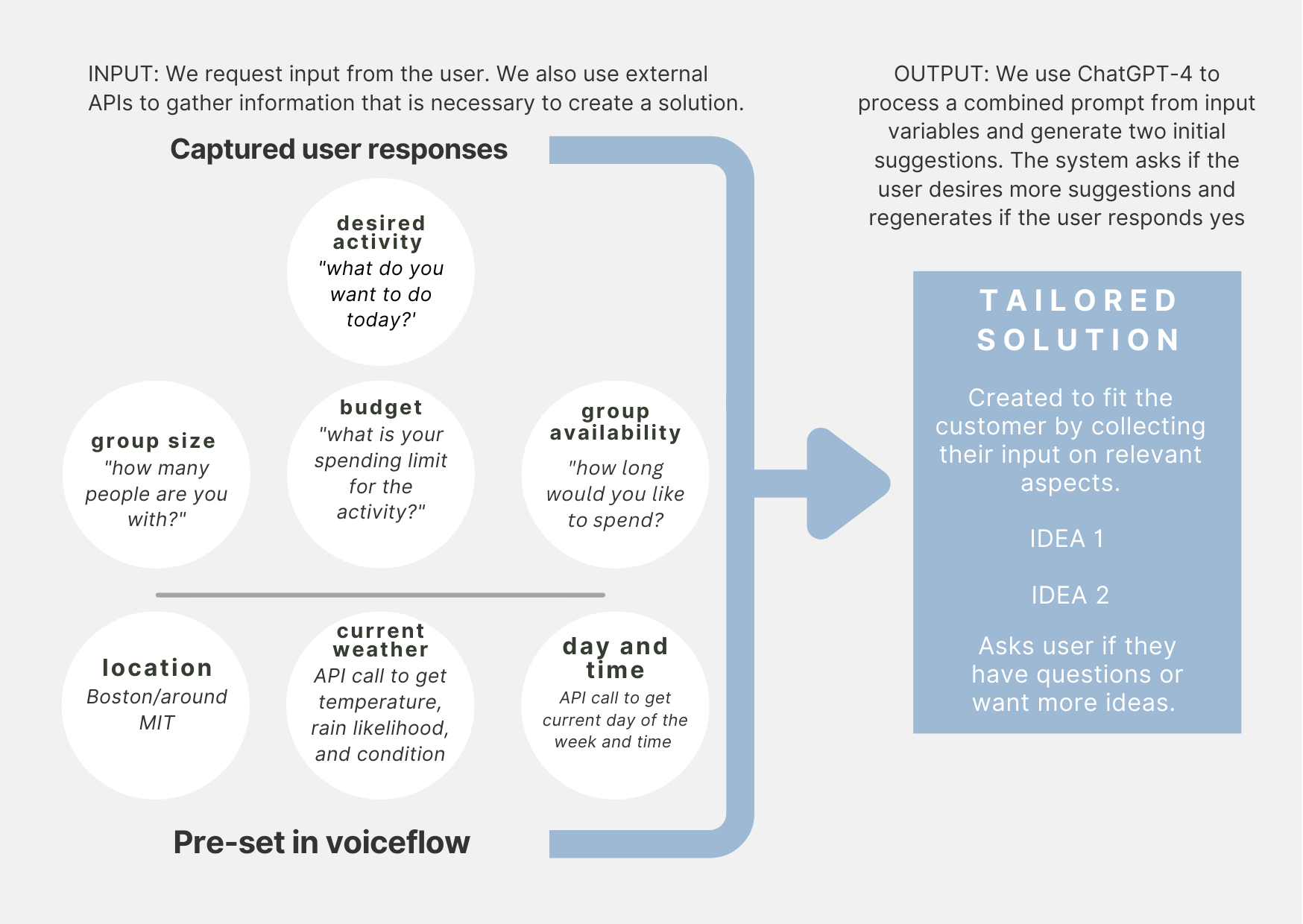Developing a skill for the speech recognition system (Alexa), final project for MIT 6.910 Design-Thinking and Innovation in Engineering. Eventful is an engineering project aimed at developing a conversational AI system capable of generating and managing events. The system is designed to simplify the free-time planning process for college individuals.
Currently students in the Boston area struggle finding activities and making plans to hang out with friends outside of school. They spend more time searching and discussing what to do unsuccessfully, there are many factors that have to be taken into consideration and the current platforms like TikTok, Google Maps, Yelp, among others do not provide full information about what seasonal activities there are that fit their interests.
We wanted to build an Alexa assistant that would be able to have an impact on something that personally affected us and that utilized some of the already known Alexa's assistant features. We settled on our direction after comparing our generated ideas and identifying a shared common goal of simplifying our schedules and managing time.
Main Takeaway:
We were all interested in having an Alexa skill that could help us organize our to-do list and also give recommendations for places to eat, and shop, and spend our free time. This signified that this was a relevant problem space and that we lacked a satisfying solution.
An Alexa voice assistant that recommends ideas for how a user should spend their free time based on a number of factors including weather, date/schedule, and category of the desired event, all while utilizing third-party services like weather APIs. Our system will receive user input, identify keywords and produce AI-generated suggestions for the user's free time.

Chloe Collegian
Chemical engineering student at MIT, age 21, Aries
Challenges:
• Too many tasks to do and overworked and stressed
• Often too tired to think of things to do with friends, planning wastes time
Needs:
• Cut down on wasted time planning activities that could be spent sleeping, psetting, or eating
• Breaks in between assignment deadlines
Values:
• Quality time with people
• The ability to contrast free time and work time
• Prioritizing her wellbeing and sleep quality
They
.png)
They

Testing was essential for us to improve our product and learn from natural and raw interactions. We tested a wide range of college students from MIT and Wellesley aged 18 to 23. We gathered a diverse group of participants with different backgrounds ranging from people who own Amazon Alexa assistants to people who have had limited interactions with assistants like Siri.
Main findings:
- Our testers found our voice assistant very robotic, as we did not have a user-friendly flow and did not provide a complete context of how the system works. The assistant was not particularly clear to individuals when it came to the prompt and natural flow of conversation.
-Sometimes the suggestion set would cut off prematurely. It would give two options and then end halfway through the third, prematurely ending our assistant's advice.
+ Promisingly, our users reported that the suggestions made by our event planning assistant were valuable and reasonable. Users appreciated the accuracy of our suggestions in accordance with current conditions like weather and time of season.
They
After improving on our assistant's system design, chatGPT prompt layout, and answer flow/organization we settled on a design that would work like this:
ChatGPT 4 input:
Please provide 2 options, the maximum amount of words permitted per option is 50. For a college student in Boston around MIT seeking to spend their free time doing "{Desired_Activity}"
The following are factors and constraints to consider and base your options on.
Please factor weather into decisions if activities will be outdoors:
Weather info: {temperature} degrees
Precipitation info: {probability_of_precipitation}} % chance
Time of day/week/season: {time} {day_of_week}
Group Size: {group_info}
Cost preference: {group_budget}
User time allotment for activity: {group_time}
Example conversation with a new user planning a small lunch hangout with friends:
.png)
It is important to keep in mind that the tone, pauses, and words of affirmation/ acknowledgement have a big impact on the users experience! This was a challenging project where I observed how design systems of information and order affected the outcome of the information obtained from chatGPT. One thing is using chatGPT in your desktop and having the chance to ask follow up questions and give more information you want the AI to know, another thing is having to deliver the answer within the scope in one try... Something that saved us a lot of time and extra efforts was low fidelity prototyping, it allowed us to start with the vision we had and get a real perspective of how much information we would be able to gather and how specific we would need responses to be.